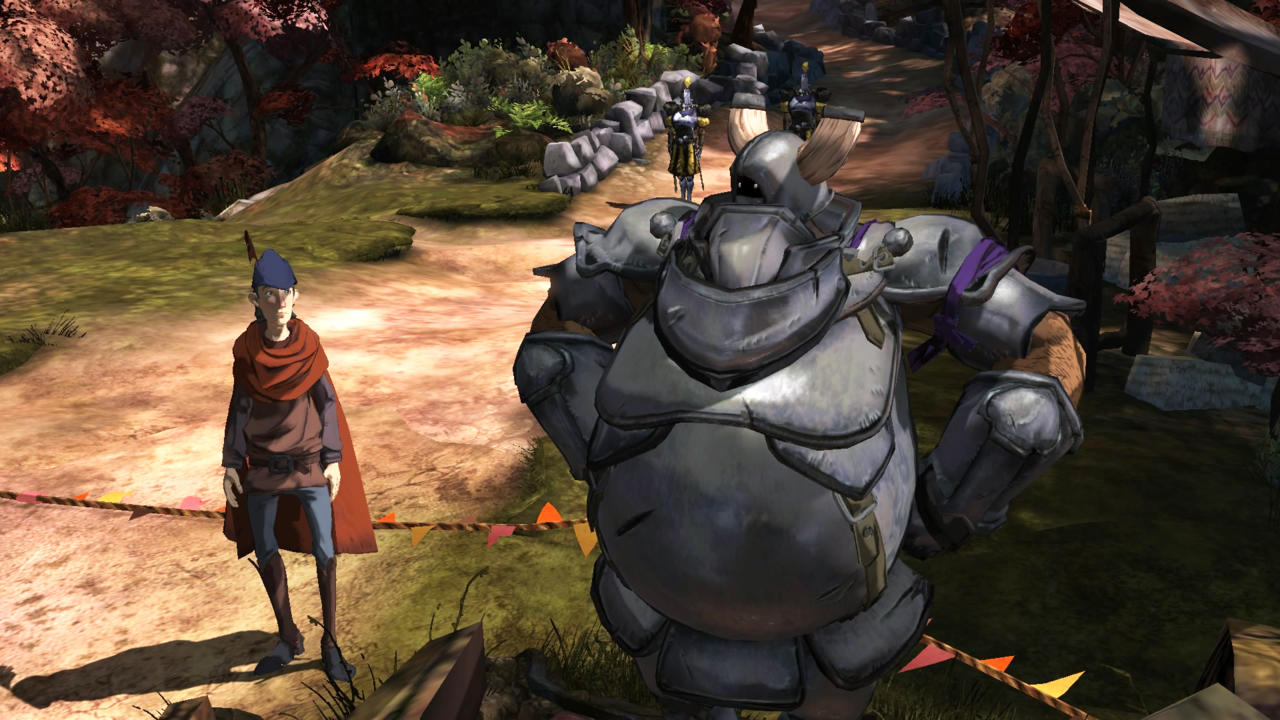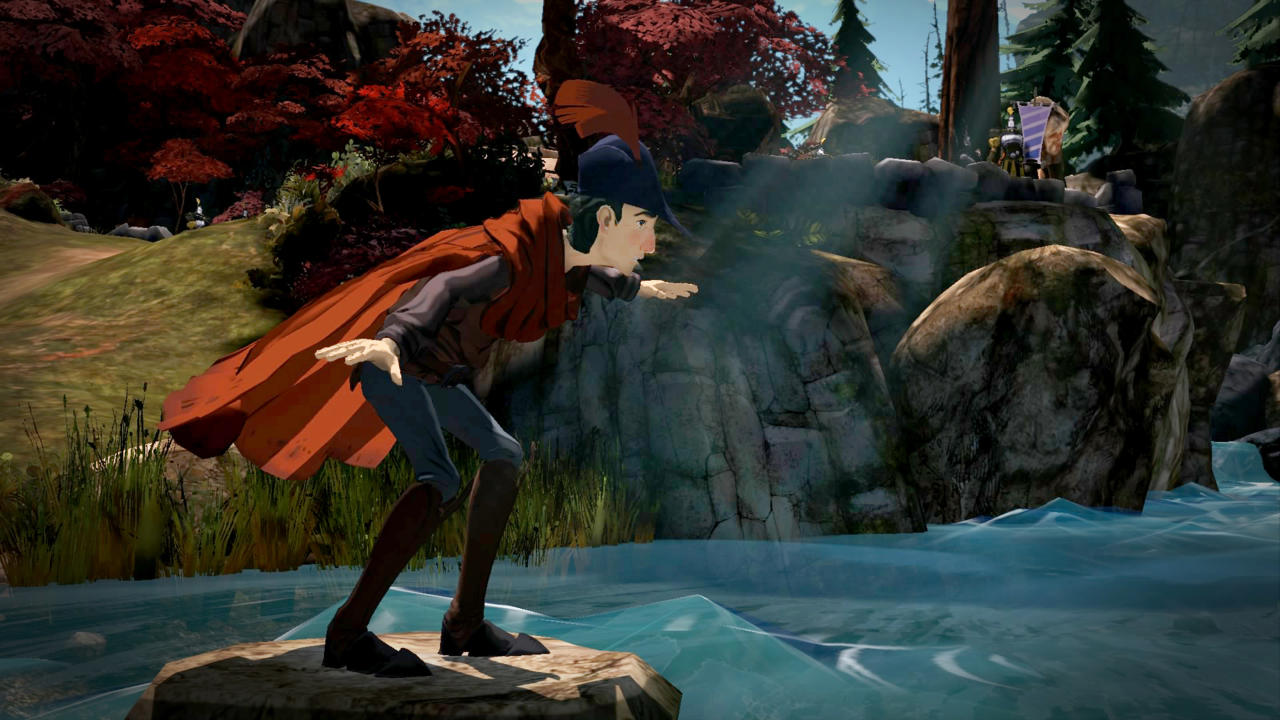Many games have aimed for a "bedtime story" vibe, but few capture the charm of a tall tale as told to a youngster by an adult she looks up to. Prince of Persia: The Sands of Time is one game that understood the magic of a fairy tale, and I suspect the upcoming narrative adventure King's Quest will be another. It was Sands of Time as much as the original King's Quest games that my mind kept returning to as I recently watched the gorgeous King's Quest in motion, and that connection alone is enough to warm my heart and leave it open to the scenarios that developer The Odd Gentlemen--and creative director Matt Korba--are concocting.
That fairy-tale atmosphere arises in part from King's Quest's framing device. The adventures you embark upon are those from the aging King Graham's past, as told to his granddaughter Gwendolyn. Korba compares the framework to The Princess Bride and Big Fish--films that portray the imaginative and fantastical past of a storyteller hoping to preserve a timeless tale. The themes of that story will be up to you. Is this a story of bravery and strength, or is it one of compassion and wisdom? How you guide Graham's story will impact the very core of the fable, and Gwen herself will internalize the fable as advice for how to lead her own life. In this way, you aren't just forming Graham's past, but Gwen's future. It's a twist that brings to mind another work of art that plays out as a living fairy tale: Stephen Sondheim's Into The Woods. "Careful the things you say," sings the witch. "Children will listen." I know when I finally make these choices for myself in King's Quest, I will be doing so not just to piece together a past for Graham, but to piece a future together for Gwendolyn.
Paper Mario: The Thousand-Year Door – Official Switch Overview Trailer Sand Land Review Stellar Blade - Official Launch Trailer | PS5 Games SaGa Emerald Beyond – Official Launch Trailer Another Crab's Treasure Is A Soulslike 3D Platformer | GameSpot Review Stellar Blade Review That Time I Got Reincarnated as a Slime ISEKAI Chronicles – Official Announcement Trailer MEGATON MUSASHI W: WIRED – Official OP “MUSASHI English Ver.” Trailer Gothic 1 Remake | Official Collector's Edition Trailer Super Monkey Ball Banana Rumble - Official Multiplayer Features Trailer PUBG | Erangel Classic Returns Genshin Impact - "Arlecchino: Afterglow of Calamity" | Collected Miscellany
Please enter your date of birth to view this video
By clicking 'enter', you agree to GameSpot's
Terms of Use and Privacy Policy
Another feature in King's Quest that recalls The Sands of Time is the manner in which Graham re-remembers his story when you lead him to an unexpected demise. Death was a vital part of the original King's Quest games, and Korba is maintaining the tradition. Korba guided Graham through a dragon's cave with a controller, though the PC version supports keyboard and mouse, naturally. There, he encountered a contraption featuring a chain, a bed, and a skeleton whose deceased owner was taking a longer nap than he'd intended. There were two levels to pull: one on the left, next to the mattress of death, and one on the right. Korba asked me which to choose, and there was no question: the one on the left. And of course, that was the lever that proved how a mattress could be a murder device. But that's not really how the story went. "And that's what would have happened if I had pulled the left switch," Graham intones. I'm tempted to Kill Graham as often as possible when I play the final game, just to see how many ways he can reframe inadvertent death.
I'm thrilled that King's Quest wants to kill me. It's part of the series' legacy, and Korba is frightfully aware of what the old Sierra adventures mean to their fans. "Since I'm a huge fan of King's Quest, this has been very nervewracking," Korba told me. "I didn't want to do it unless I could get the support of [King's Quest creators] Ken and Roberta Williams. Luckily, some people pulled some strings so I could show them the game at an early state, and to get their support and help early on. That was mind-blowing, and we got to meet, and luckily, they really liked what we were doing. We had some really great conversations, not just about games and adventure games, but also our company, because we want to create these family-friendly experiences that we feel are lacking. We're all getting older, I'm having kids, and I want to make games that I can share with my kids, just like I used to play the old King's Quest games with my dad and my uncle."
It was never, 'We need to design this crazy creature because that would be badass.' It needs to fit in the story.
Creative Director Matt Korba
You will discover plenty of nods to the original adventures--the initial scenes in the dragon's cave are reimaginings of a classic King's Quest puzzle, after all--but Korba wants the game to be inclusive, not exclusive. The jokes may refer to old gags, but Korba says they'll be funny on their own terms, regardless. I don't need to take Korba's word regarding the game's gorgeous visuals, however: the game is beautiful and vibrant, and Graham moves through it with exceptional grace, with his cape flowing behind him. All of the backgrounds are hand-drawn: the 3D models were printed to paper, painted with watercolors, and then scanned back into the game. The technique makes for a stunning look.
Nothing in King's Quest is being made to simply look cool, however. Every sight has meaning. Says Korba, ""You're gonna see a lot of weird things in here, like--why has that skeleton been crushed by a bed? Who put those two switches there? You'll find out those answers as you keep playing the game. We actually revisit this same area five years in the past, and you'll start to see how it all fits together."

"We never design anything to be badass," Korba added. "It was never, 'We need to design this crazy creature because that would be badass.' It needs to fit in the story. We're a small team, we're only 20 people. So we had to use every piece of the buffalo. If you see a character and you think, 'Oh, it's just a minion.' No, no, no--you're going to learn all about this character, and he's gonna fit back into the story." That's comforting to me, actually: everywhere I looked, beds and mattresses covered the ground. There was a bridge made entirely out of beds and bunks, and beds and mattresses dangled from the ceiling like stalactites. A stream running through the cave, meanwhile, was known as "The River of Rumbling Trundles." It's a cute and striking use of beds, but they're not there just because it's a neat idea: every detail has a story to tell--and Korba intends on making sure you hear it.
The puzzles through this sequence are simple: you hide from the dragon by leaping into a bed, you distract the creature with a giant slab of meat, you avoid being detected by walking around noisy piles of brittle bones, and so forth. (Bear in mind that the sneaking, like other gameplay elements such as shooting a bow or jumping across rocks, is entirely contextual. King's Quest is an adventure game, not a platformer or a stealth game.) However, you will eventually have to deal with that pesky dragon one way or another, but how you do that is your call.
We're all getting older, I'm having kids, and I want to make games that I can share with my kids, just like I used to play the old King's Quest games with my dad and my uncle.
Matt Korba
Says Korba, ""We really want our players to skin their own emotions onto the dragon. Whether you want to believe that the dragon is a horrible, hideous beast, or a misunderstood creature, that's completely up to you. At the end of this section, you get a choice: Are you going to free the dragon, fight the dragon, or distract the dragon? And that colors the story that you're telling Gwendolyn. So either way, you're going to tell a story about how you defeated the dragon. But if you're telling a story about how you fought against a hideous beast, or you're telling one about how you made a friend in an unexpected place, that's completely up to you."
The scene I saw next leaned heavily on humor, but did so in ways that made it easy to root for the younger, naive Graham, who had yet to become the hero he wanted to be. The source for much of that humor was a tiny, elderly merchant who yammered so quickly it was hard to keep up. As was the case in the rest of the demo, musical cues directly mirrored the onscreen action so well, I was convinced that the late Looney Tunes composer Carl Stalling had composed it from beyond the grave. (At one point, the merchant waved goodbye to Graham and cried out "Bon voy-adj-ee!" just as Bugs Bunny has done in countless cartoons, cementing the Looney Tunes connection in my mind.)

The remainder of the jokes established Graham as an underdog. He arrived at a festival where he hoped to prove his heroism by becoming a knight, only to discover that the bridge leading to his destination was out. Solving each puzzle in this area would seem to lead Graham across the chasm--toppling a tree or creating a rope swing, for example--but instead, his fellow contestants would take advantage of his ingenuity and beat him to the punch. And finally, when Graham found his way by crafting a makeshift raft, another hopeful knight still proved quicker. Each event was funnier than the last, but as a whole, they were heartbreaking: Graham had yet to catch a break. He was living out a classic hero's tale, the kind that establishes the hero as down on his luck before allowing him to blossom.
"Classic" describes King's Quest on the whole, actually, though you shouldn't assume that Korba and company are just trying to copy the old games and hoping we won't notice. Says Korba, "I look at this the way they redo The Wizard of Oz, or Peter Pan. It's this cherished, loving thing, and this is our take on it. We're not throwing out the canon that they already established. We're fitting our stories between those, or taking bits of those and reimagining parts of it." With luck, a new generation can venture to lands in 2015 that captured this old heart so many years ago.

